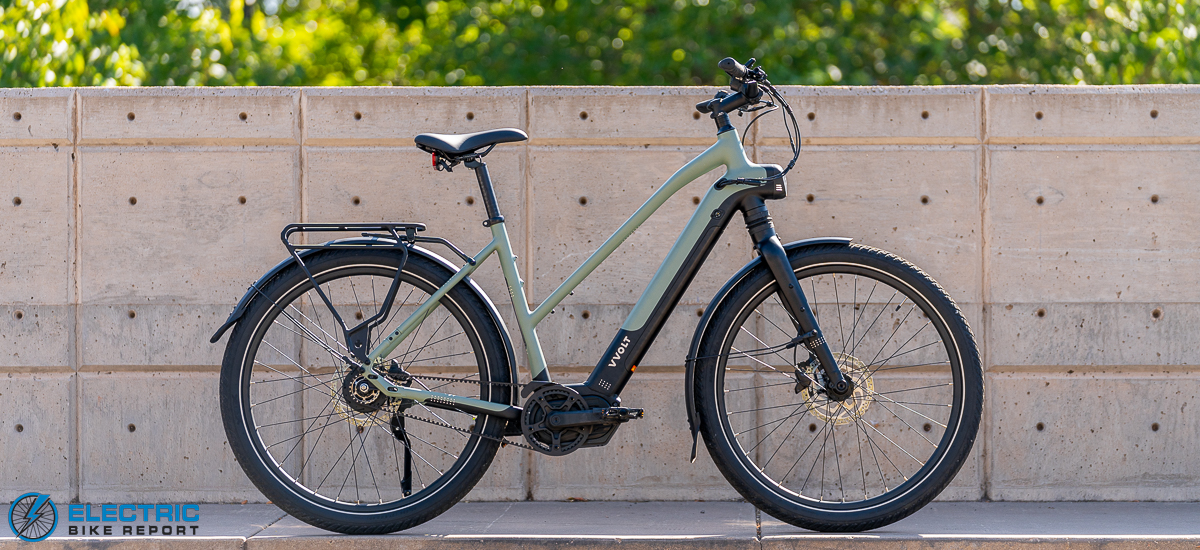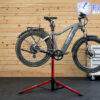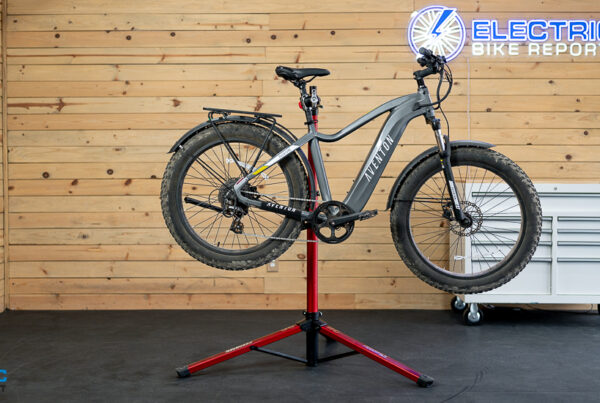While more subjective than our data-based tests, discussing ride quality (how a bike feels to ride) is every bit as important. In this section, we will discuss many aspects of the ride, including the Centauri II’s sizing and fit, overall comfort, suspension, handling, user interface, etc.
Vvolt manufactures this model in three sizes: S/M, M/L, and L/XL. The S/M fits riders from 4’9” to 5’8”, while the M/L is sized for those between 5’4” and 5’10”, with the L/XL accommodating a range from 5’8” to 6’4”.
We tested the L/XL frame, which was sized appropriately for my height of 5’11”. With 8” of saddle height adjustment, I had full leg extension for pedaling efficiency. The bike’s geometry pitches the rider forward somewhat, though I found this position to be comfortable and not too aggressive.
Overall, I found the bike to be comfortable, thanks to its gel saddle, ergonomic rubber grips, and wide handlebars. The handlebars, in particular, were a highlight—providing excellent stability and steering control. Thanks to these (and the bike’s relatively low weight), its handling was fast and responsive, giving the bike an agile feel.
The bike features a proprietary “monoshock” suspension in the head tube; this mechanical coil-based system provides 30mm of travel to smooth bumps and dips. I found that it generally felt good when riding over small imperfections, but it seemed a bit stiff and bottomed out when riding over larger obstacles, such as the edge of a sidewalk.
Instead of a throttle, the Centauri II has a Boost button mounted on the right handlebar. After a short delay, this button provides motor power for four seconds; our test bike would provide a low-power boost from a standstill or a max-power surge when riding above five mph. Our contact at Vvolt said the help at startup would not exist with 2025 models.
I noticed that once the Boost function was engaged, applying the brakes did not cut the motor’s power output, so there were a few times when the bike felt like it was starting to get away from me. We encourage Vvolt to include a motor cutoff feature for safety.
We also appreciate the brand’s efforts to encourage a more active experience, but we believe most riders will prefer a throttle over the Boost button. From personal experience, I can attest that I use the throttle most when picking up from a stop at an intersection. As such, we’d prefer a traditional throttle, even if it were limited to, say, 10 mph.
Otherwise, the bike’s user interface is minimalistic and straightforward; aside from the brake levers, display, and button panel, its cockpit is clean and simple. I appreciated the bike’s color display and the fact that its PAS settings are color-coded for ease of reference.
I also really liked the Centauri’s styling; the sleek and streamlined fusion of the down tube and headlight is a great touch on Vvolt’s newest models. It’s important for a brand to have a visual identity, and Vvolt successfully found theirs. Looks are certainly subjective, but I’m absolutely a fan!
Considering the Centauri II’s price point of roughly $3k at the time of writing, I hoped to see brake lights instead of a simple tail light; this would be an appreciated upgrade in the future. Our test bike was equipped with an optional cargo rack that we’d appreciate having included with the base cost as well.
Otherwise, the bike’s quick handling, easy operation, and responsive motor output were defining features that served to elevate its ride quality to an uncommon degree. It was a joy to be able to hop on the bike and simply ride without thinking about anything beyond the initial pedal assist level (or switching in the event of a hill).
Overall, the Centauri II’s ride quality is excellent, making it an easy bike to recommend.
.
.
.
#Vvolt #Centauri #Review #Doesnt #Easier
Source link








